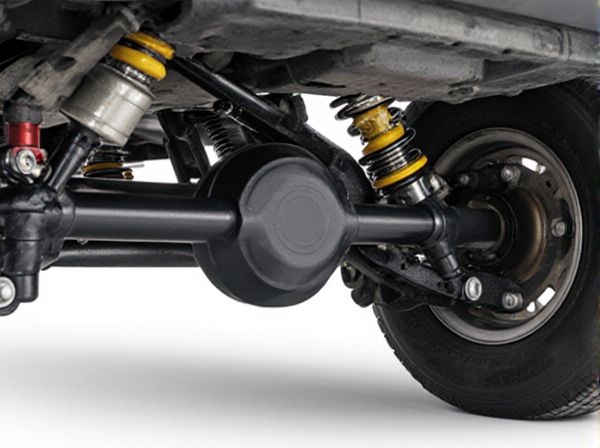
Photo illustration: Cantilever Suspension vs Rigid Axle
Cantilever suspensions offer improved ride comfort and better handling by allowing independent wheel movement, reducing road shock transmitted to your vehicle. Rigid axles provide durability and are simpler to maintain, making them ideal for heavy-duty applications and off-road use. Choosing between these suspension types depends on whether you prioritize smooth driving dynamics or rugged reliability.
Table of Comparison
| Feature | Cantilever Suspension | Rigid Axle Suspension |
|---|---|---|
| Design | Uses lever arms pivoted on the frame to support the axle | Solid beam connects both wheels directly, moving as one unit |
| Ride Comfort | Better absorption of road shocks, smoother ride | Less effective shock absorption, rougher ride quality |
| Handling | Improved wheel articulation and independent movement | Limited wheel movement, reduced handling precision |
| Durability | Complex design, moderate durability under heavy loads | Robust, high durability suitable for off-road and heavy-duty |
| Maintenance | Higher maintenance due to moving parts and linkages | Lower maintenance with simpler mechanical structure |
| Weight | Lighter suspension system | Heavier due to solid axle construction |
| Cost | Generally more expensive | Cost-effective and cheaper to produce |
Introduction to Suspension Systems
Cantilever suspension utilizes a lever arm connected to a pivot point, providing enhanced wheel articulation and improved ride comfort by isolating road shocks more effectively. In contrast, rigid axle suspension features a solid beam connecting the wheels, offering robustness and simplicity but often transmitting more road imperfections to the chassis. Choosing between cantilever and rigid axle systems depends on factors like vehicle load capacity, terrain conditions, and desired handling characteristics.
What is Cantilever Suspension?
Cantilever suspension is a type of vehicle suspension system where the wheels are connected to the chassis via arms that act as levers, allowing vertical movement to be absorbed by springs or dampers positioned away from the wheel hub. This design reduces unsprung weight and improves ride comfort by isolating road shocks from the vehicle body. In contrast, a rigid axle connects the wheels on each side with a solid beam, resulting in less independent wheel movement and typically a stiffer ride.
Understanding Rigid Axle Suspension
Rigid axle suspension features a solid beam connecting both wheels, ensuring synchronized movement and durability in heavy-duty applications such as trucks and off-road vehicles. This design provides consistent wheel alignment under load, enhancing stability and strength on rough terrain compared to Cantilever Suspension systems. Understanding rigid axle suspension is essential for optimizing vehicle performance in conditions requiring robust support and lasting reliability.
Key Differences Between Cantilever and Rigid Axle
Cantilever suspension features independent movement with arms fixed at one end, providing enhanced ride comfort and improved handling by isolating wheel motion, whereas rigid axle suspensions connect wheels with a solid beam, delivering greater durability and load capacity but limited suspension articulation. Cantilever setups typically offer reduced unsprung weight compared to rigid axles, enhancing vehicle responsiveness and traction on uneven terrain. The rigid axle's simple design supports heavy-duty applications but sacrifices the independent wheel travel and smoother ride quality characteristic of cantilever systems.
Performance Comparison: Ride Quality
Cantilever suspension systems provide superior ride quality by offering enhanced flexibility and better shock absorption, resulting in smoother rides over uneven surfaces compared to rigid axle setups. Rigid axles, while robust and durable, tend to transmit more road vibrations directly to the vehicle frame, leading to a harsher ride experience. The improved articulation and independent movement of cantilever suspensions contribute to increased comfort, particularly in off-road and rough terrain conditions.
Durability and Maintenance Factors
Cantilever suspension systems offer enhanced durability by reducing stress concentrations and improving load distribution, which minimizes wear on components compared to rigid axles. Maintenance demands for cantilever setups are generally lower due to fewer moving parts and better resistance to deformation, resulting in less frequent repairs. Rigid axle systems, while simpler and more robust initially, often require more regular upkeep to address wear and alignment issues caused by constant load pressures.
Application in Modern Vehicles
Cantilever suspension systems provide enhanced ride comfort and improved wheel articulation, making them ideal for off-road and heavy-duty vehicles requiring greater flexibility and load distribution. Rigid axle suspensions offer durability and simplicity, commonly used in trucks and SUVs where strength and cost-effectiveness are prioritized. Modern vehicles increasingly combine cantilever suspension features with rigid axle robustness to balance performance, handling, and passenger comfort.
Cost Implications of Each System
Cantilever suspension systems generally have higher initial costs due to their complex design and advanced materials, leading to increased manufacturing and maintenance expenses. Rigid axle suspensions offer lower installation and repair costs, making them more cost-effective for budget-conscious applications despite potentially reduced ride comfort and handling. Long-term cost analysis often favors cantilever systems in performance vehicles for improved durability and lower frequency of component replacement.
Pros and Cons of Cantilever Suspension
Cantilever suspension offers superior wheel articulation and improved ride comfort by isolating the shock absorbers from direct axle movement, making it ideal for off-road and rough terrain conditions. Its design reduces unsprung weight and allows for easier maintenance and adjustments compared to rigid axles, but it tends to be more complex and costly to manufacture and repair. While cantilever suspension excels in handling and performance, it may lack the durability and simplicity that rigid axles provide for heavy-duty or load-bearing applications.
Pros and Cons of Rigid Axle Suspension
Rigid axle suspension offers superior durability and load-bearing capacity, making it ideal for heavy-duty vehicles and rough terrain. However, it compromises ride comfort and handling precision due to limited independent wheel movement, resulting in increased vibration and less responsive steering. Maintenance is generally simpler and more cost-effective, but the rigid design can lead to uneven tire wear compared to independent suspension systems.
 caratoz.com
caratoz.com